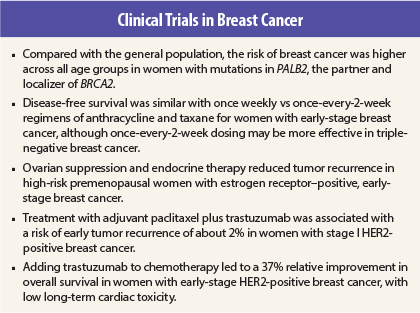Anyone who has attended the major oncology meetings knows that research from clinical trials in breast cancer often dominates the stage, with countless abstracts featuring new and updated results. To help the readers of The ASCO Post stay up to date with the latest discoveries and findings impacting the treatment of women with breast cancer, I have assembled highlights from a collection of newsworthy studies featured over the past year and into early 2015.
Presented here is Part 1 of this review, which centers on genetics and adjuvant therapy for several different receptor types of breast cancer. Part 2, which will appear in an upcoming issue of The ASCO Post, will focus on new therapeutic options for metastatic disease (such as palbociclib [Ibrance] and pictilisib) as well as several survivorship issues (such as fertility preservation, diet, and exercise).
Mutations in PALB2
In a study by Antoniou and colleagues,1 362 members of 154 families who had deleterious truncating, splice, or deletion mutations in PALB2—the “partner and localizer of BRCA2,” whose protein product works with and stabilizes the BRCA2 protein—were assessed to determine the cumulative risk of breast cancer. Germline loss-of-function mutations in this gene are known to confer a predisposition to breast cancer. The investigators used a modified segregation-analysis approach to estimate the age-specific breast cancer risk for carriers of PALB2 mutations.
Key Findings: Compared with the general population, the risk of breast cancer for female PALB2 mutation carriers was eight to nine times higher among those younger than age 40, six to eight times higher among those between the ages of 40 and 60, and five times higher among those older than age 60. The absolute breast cancer risk was 33% (95% confidence interval [CI] = 25%–44%) for these PALB2 mutation carriers by age 70 with no family history of breast cancer and 58% (95% CI = 50%–66%) for those with two or more first-degree relatives with breast cancer at 50 years of age.
The investigators think their data suggest that the breast cancer risk for PALB2 mutation carriers may overlap with that for BRCA2 mutation carriers. In addition, PALB2 is identified as the second most important susceptibility gene for familial pancreatic cancer, right after BRCA2.
Clinical Perspective: BRCA1 and BRCA2 are well studied, and the related risk of breast and ovarian cancers is well established. In the clinic, however, we see many patients who have a strong family history of early breast and ovarian cancers but are negative for the BRCA mutation. Identification of more genes such as PALB2 will help us to treat these patients better and craft risk-reduction strategies. Genetic evaluation, counseling, testing, and preventive approaches will continue to evolve as data accumulate on these mutations.
Adjuvant Therapy: Focus on Treatments by Receptor Status
Highlighted here are the SWOG S0221 study on high-risk, early-stage breast cancer; two related studies (the TEXT and SOFT trials) on hormone receptor–positive breast cancer; and two studies on HER2-positive breast cancer.
SWOG S0221
In the phase III SWOG S0221 study, Budd and colleagues attempted to determine the optimal dose and schedule combining anthracycline and taxane administration in the adjuvant treatment of 3,250 women with early-stage node-positive or high-risk node-negative breast cancer.2 The four comparison regimens included a continuous schedule of doxorubicin-cyclophosphamide, six cycles of doxorubicin-cyclophosphamide once every 2 weeks, paclitaxel once a week, and six cycles of paclitaxel once every 2 weeks.
Key Findings: Patients achieved a similar disease-free survival on any of the regimens studied, with interim analyses crossing the futility boundaries for demonstrating superiority of both once-per-week regimens and once-every-2-week regimens. However, according to a subset analysis, once-every-2-week dosing may be best for women with triple-negative breast tumors (estrogen receptor–negative, hormone receptor–negative, and HER2-negative).
Clinical Perspective: The updated results of ECOG 1199 confirmed that weekly paclitaxel is superior to every-3-week paclitaxel.3 In that particular study, a dose-dense regimen was not tested. SWOG S0221 is the only study to compare weekly paclitaxel with every-2-week treatment and suggests that either regimen is acceptable for estrogen receptor–positive patients but that every-2-week treatment may be better for triple-negative disease.
TEXT and SOFT Trials
The TEXT and SOFT trials focused on the use of adjuvant ovarian suppression in combination with an aromatase inhibitor4 or tamoxifen5 in the treatment of premenopausal women with hormone receptor–positive breast cancer. In the two phase III studies, the investigators compared the use of the aromatase inhibitor exemestane plus ovarian suppression with tamoxifen plus ovarian suppression for 5 years. The gonadotropin-releasing hormone agonist triptorelin (Trelstar), oophorectomy, or ovarian irradiation was used to achieve suppression of ovarian estrogen production. Combined data from 4,690 patients in the two trials were included in the primary analysis.
Key Findings: Adjuvant treatment with exemestane plus ovarian suppression significantly reduced tumor recurrence over tamoxifen plus ovarian suppression. The disease-free survival at 5 years was 91% in the group that received the aromatase inhibitor and 87% in the group that received tamoxifen (hazard ratio [HR] for disease recurrence, second invasive cancer, or death was 0.72, 95% CI = 0.60–0.85, P < .001).
Furthermore, adding ovarian suppression to tamoxifen did not provide a significant benefit in the overall study population. For high-risk women who remained premenopausal, the addition of ovarian suppression improved disease outcomes.
Clinical Perspective: From the Oxford overview analysis and other studies, it is well known that ovarian suppression will potentially benefit patients with early-stage breast cancer. However, we lacked direct evidence in the form of a prospective, randomized trial. Now, with the SOFT and TEXT trial results showing a clear benefit, it is important to consider ovarian suppression in addition to endocrine therapy for estrogen receptor–positive, high-risk premenopausal patients.
Adjuvant Paclitaxel and Trastuzumab
In a phase II study of more than 400 patients with node-negative, small HER2-positive breast tumors (measuring up to 3 cm in greatest dimension),6 Tolaney and colleagues assessed the weekly treatment of paclitaxel and trastuzumab (Herceptin) for 12 weeks, followed by 9 months of trastuzumab monotherapy. Most of these women were ineligible for the pivotal trials of adjuvant trastuzumab.
Key Findings: The 3-year invasive disease-free survival rate was 98.7% (95% CI = 97.6–99.8), which the investigators considered to be “better than expected” based on the historic data. Of the 12 relapses reported, 2 were the result of distant metastatic breast cancer. The investigators concluded that treatment with adjuvant paclitaxel plus trastuzumab was associated with a risk of early tumor recurrence of about 2% in women with predominantly stage I HER2-positive breast cancer. However, they noted that 6% of patients withdrew from the study because of protocol-specific adverse events.
Clinical Perspective: For women with small HER2-positive, estrogen receptor–positive tumors, the role or benefit of chemotherapy in addition to HER2 blockade and endocrine therapy has not been clear. This study and regimen clearly offer a less-toxic regimen with trastuzumab, which should change our practice in these low-risk patients.
NSABP B-31 and NCCTG N9831
The joint analysis from NSABP B-31 and NCCTG N9831 focused on the use of trastuzumab along with adjuvant chemotherapy for more than 4,000 women with HER2-positive breast cancer.7 In both trials, women with operable breast tumors received doxorubicin and cyclophosphamide followed by paclitaxel with or without trastuzumab.
Key Findings: Adding trastuzumab to chemotherapy led to a 37% relative improvement in overall survival (HR = 0.63, 95% CI = 0.54–0.73, P < .001) as well as an increase in the 10-year overall survival rate from 75% to 84%. In addition to these results, an improvement in disease-free survival of 40% (HR = 0.60, 95% CI = 0.53–0.68, P < .001) was reported. Finally, all patient subgroups benefited from the addition of this targeted anti-HER2 agent.
Clinical Perspective: Two key findings from this long-term follow-up analysis are the continued benefit of trastuzumab beyond 5 years and up to 10 years as well as the very low rate of long-term cardiac toxicity in the patients who were treated with trastuzumab. ■
Disclosure: Dr. Abraham reported no potential conflicts of interest.
References
1. Antoniou AC, Casadei S, Heikkinen T, et al: Breast-cancer risk in families with mutations in PALB2. N Engl J Med 371:497-506, 2014.
2. Budd GT, Barlow WE, Moore HC, et al: SWOG S0221: A phase III trial comparing chemotherapy schedules in high-risk early-stage breast cancer. J Clin Oncol 33:58-64, 2015.
3. Sparano JA, Zhao F, Martino S, et al: Ten year update of E1199: Phase III study of doxorubicin-cyclophosphamide followed by paclitaxel or docetaxel given every 3 weeks or weekly in patients with axillary node-positive or high-risk node-negative breast cancer. 2014 San Antonio Breast Cancer Symposium. Abstract S3-03. Presented December 11, 2014.
4. Pagani O, Regan MM, Walley BA, et al: Adjuvant exemestane with ovarian suppression in premenopausal breast cancer. N Engl J Med 371:107-118, 2014.
5. Francis PA, Regan MM, Fleming GF, et al: Adjuvant ovarian suppression in premenopausal breast cancer. N Engl J Med 372:436-446, 2015.
6. Tolaney SM, Barry WT, Dang CT, et al: Adjuvant paclitaxel and trastuzumab for node-negative, HER2-positive breast cancer. N Engl J Med 372:134-141, 2015.
7. Perez EA, Romond EH, Suman VJ, et al: Trastuzumab plus adjuvant chemotherapy for human epidermal growth factor receptor 2-positive breast cancer: Planned joint analysis of overall survival from NSABP B-31 and NCCTG N9831. J Clin Oncol 32:3744-3752, 2014.



